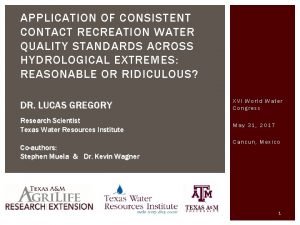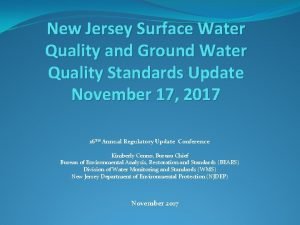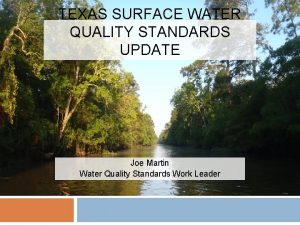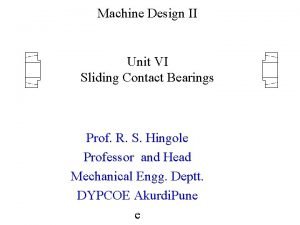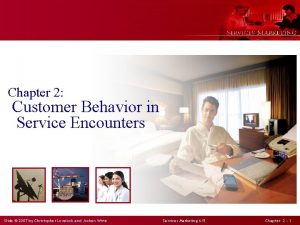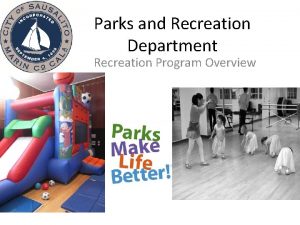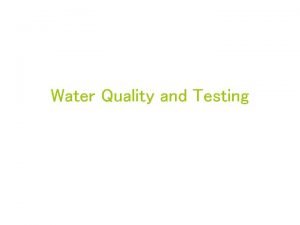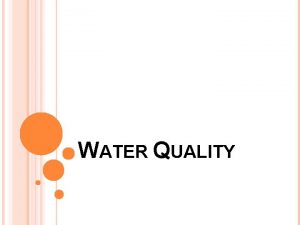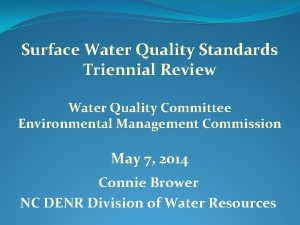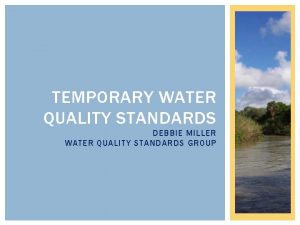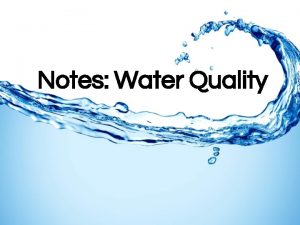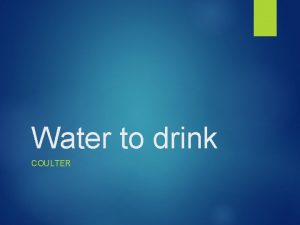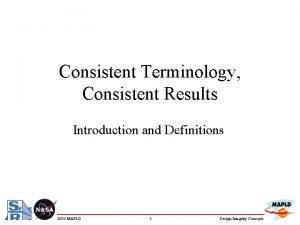APPLICATION OF CONSISTENT CONTACT RECREATION WATER QUALITY STANDARDS












- Slides: 12

APPLICATION OF CONSISTENT CONTACT RECREATION WATER QUALITY STANDARDS ACROSS HYDROLOGICAL EXTREMES: REASONABLE OR RIDICULOUS? DR. LUCAS GREGORY XVI World Water Congress Research Scientist Texas Water Resources Institute May 31, 2017 Co-authors: Stephen Muela & Dr. Kevin Wagner Cancun, Mexico 1

WATER QUALITY STANDARDS Describe desired condition of waterbody Form legal basis for controlling pollution Advise user of potential health risks Consist of: Designated Uses Numeric Criteria Antidegradation Requirements General Policies 2

CONTACT RECREATION Primary contact – activities with presumed significant risk of water ingestion § Swimming, children wading, water skiing, surfing, diving, tubing, whitewater sports (kayaking, rafting) Secondary contact 1 – commonly occurring activities with limited body contact; less ingestion risk than primary contact § Adults wading, fishing, canoeing, kayaking, boating Secondary contact 2 –limited body contact activities with less ingestion risk due to physical waterbody characteristics and limited access § Fishing, canoeing, kayaking, boating Noncontact – activities with no significant risk of ingestion; where activities should not occur due to unsafe conditions § Birding, hiking, biking; contact prohibited by law 3

RECREATION TYPES 4

PROTECTING HUMAN HEALTH § Contact recreation standards provide reasonable assurance that human health risk from fecal pollution is acceptable § Feces contains § Pathogens including cryptosporidium, pathogenic E. coli, and giardia § Non-pathogenic organisms: many strains of E. coli and fecal coliform § E. coli commonly used as Fecal Indicator Bacteria § Presence of Fecal Indicator Bacteria in water considered indicative of recent fecal contamination § Concentrations correlate to human health risk 5

E. COLI FATE IN THE ENVIRONMENT E. coli can survive for a period of time outside of the host organism in soil, water, sediment Survival influenced by temperature, moisture level, available nutrition, salinity, solar radiation, and predation levels § Levels of each vary in soil, water, and sediment Long-term survival has been documented in all environments § E. coli may not be associated with recent contamination events § Surviving E. coli can contribute to measured quantity in water samples § Baseflow contributions ~90% § Stormflow increases of ~ 2 orders of magnitude 6

CONTACT RECREATION STANDARDS APPLICATION IN TEXAS E. coli Public Lakes Rivers Creeks Enterococcus Bays Estuaries No considerations for flow condition No risk conferred to the person recreating due to type of activity No consideration of use type relative to flow conditions 7

NAVASOTA RIVER CASE STUDY 8

HYDROLOGIC CONDITIONS CHANGE RECREATION 9

POLICY RECOMMENDATION Risk based water quality standard Consider the number of people engaged in recreation, appropriate type of recreation, and flow condition Example considering 5, 000 swimmers and only 50 whitewater rafters per year Illn ess rate/1000 people = [Log( E. coli geometric mean)-1. 249 ]/ 0. 1064 At 12 6 cfu/100 m. L E. coli concentration: 40 swimmers get si ck; onl y 0. 4 whitewater rafters get sick Apply in g less restrictive standard to rafting conditions only stil l yie ld s ad equa te human health protection At 630 cfu/100 m. L: only 0. 72 whitewater rafters get s ic k 10

IMPLICATIONS Requires more data: water quality and recreation use Must consider type and levels of waterbody use People will assume increased level of risk when recreating Can reduce the number of waterbodies considered impaired Can reduce costs for restoring impaired waterbodies 11

QUESTIONS? Lucas Gregory LFGregory@ag. tamu. edu 12
 Water and water and water water
Water and water and water water Primary contact recreation
Primary contact recreation Njdep groundwater quality standards
Njdep groundwater quality standards Texas surface water quality standards
Texas surface water quality standards Contact and non contact force examples
Contact and non contact force examples Advantages and disadvantages of sliding contact bearing
Advantages and disadvantages of sliding contact bearing Which is a contact force? *
Which is a contact force? * Contact vs noncontact forces
Contact vs noncontact forces Irritant contact dermatitis vs allergic contact dermatitis
Irritant contact dermatitis vs allergic contact dermatitis Is air resistance a non contact force
Is air resistance a non contact force Ohmic contact
Ohmic contact Post encounter stage in service marketing
Post encounter stage in service marketing Contact forces
Contact forces

